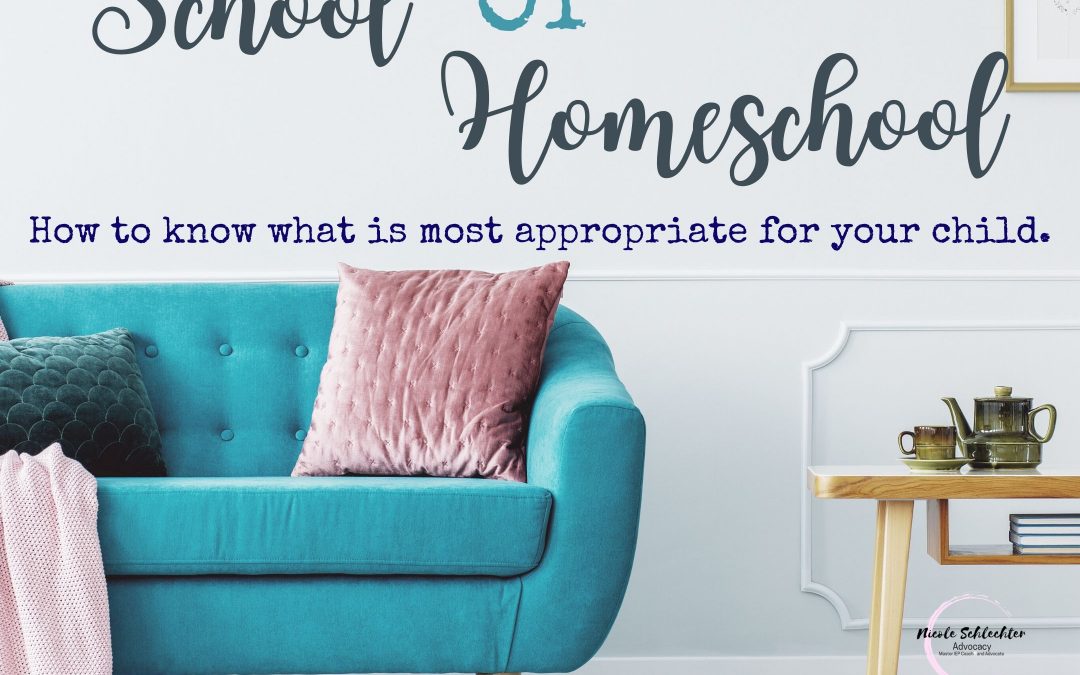To School or Not to School…. It’s the question on everyone’s mind.
Sending your child to school during a pandemic sounds nuts on paper, but when you are living in a pandemic in real life, there seems to be a lot of grey areas.
Realistically, there are children Elearning just doesn’t work for. Kids who have parents who are essential workers, who have non English speaking family members watching them, who have no internet or inconsistent internet, Incoming Kindergartners with lots of energy and unable to read, kids who need face to face connection to learn, kids who don’t have access to technology… and then there are our kids who may not be skilled enough to focus on a person who is on a screen or whose mental health impedes their ability to learn when they aren’t in a classroom. And even if you can get passed all of that, learning at home may not be an option for some parents who would have to decide between food on the table and educating their child. It may be an unpopular opinion but the kids who are successfully learning at home are privileged to be able to do so.
And then we add in a pandemic. Parents are understandably AFRAID to send their child to school and risk their health and the others around them. Y’all. This is not an easy time for any of us. There is no right answer that will fit everyone. I can’t even imagine being an administrator and trying to make all this work right now.
I’ve been reading other articles searching for some answers for you all and what I have found is incredibly biased one way or another, and that’s fine! However, I accept that what is right for my family may not be right for yours so I want you all to be able to weigh your options and decide what makes the most sense for your family.
Here are a few tips and thoughts to help you make the choice.
NOTE: Please keep in mind, I am not a lawyer. I am not offering legal advice. I will not offer legal advice.
- Homeschool and Elearning are not the same. With homeschool, you choose the curriculum. Depending on the requirements of your state, you may have to report learning to the district. Elearning is a district driven school curriculum so you most likely will be held to state standards and assessments just as if you are in school.
- Elearning, Homeschool or return to class, please do your best to connect with others who have made similar decisions. Why? Mental Health. You need a support system and your child needs social interaction. Whether that is play dates or social distance picnics, you decide, but don’t go at this alone.
- What happens to my IEP if we homeschool? This is really dependent on each district, so it is an important question to ask (with an answer in writing so it counts) before you withdraw.
- If you withdraw from school to homeschool, most likely you resign your IEP. Make sure you are asking the school what the plan is if you should return in 6 weeks, 3 months, a year etc. If you have only been gone a matter of weeks, it is likely that the school will reinstate the IEP as written, but this is important information for you to have prior to making a decision.
- My child couldn’t participate in related services over zoom, how do we keep from continued regression? This is such a hard one and again is very dependent on a lot of factors. We want to keep the lines of communication open with the school and pose the question, how do we get back to baseline? What did services look like before? How were they provided? What did they look like during spring quarantine? How can we create a plan to get back to the same level of service received before shut down? I’ve heard some schools offering services after school hours or on a walk-in basis for kids who can’t zoom. Again, there is no clear answer as to what is going to work for your child, so don’t be afraid to get creative. Every question is a no if you haven’t asked it.
- US Department of Education has offered no waivers for IDEA law. What that means is that your child is still entitled to a free appropriate public education by law. The grey area is determining what APPROPRIATE means for your child. Notice I said YOUR CHILD, not all children in this class, not all children with Autism, not all special education kids in the district… The plan should meet the unique needs of your child. Here is the latest information the department of education has put out. https://www.ed.gov/coronavirus?src=feature NOTE: If your child was not offered services in spring, let’s chat. Your child should still be receiving everything written in the IEP.
- If you decide on homeschool, Elearning or in class and change your mind, what is the process to switch instruction methods?
- And then there is the topic of mask wearing. If your state is requiring masks, is this appropriate for your child? If it isn’t appropriate how will the district accommodate your child? Do you know how the school plans to handle children who refuse a mask or remove it during the day? Will they allow exemptions?
- If your child is exposed to Covid at school, what is the school’s plan for distance learning? If you have an IEP and plan to return to class, please reach out to the school now to create a distance learning or eLearning option for your child. In some cases, even if you determine your child will return to the classroom, you may end up with an Elearning plan for a time due to exposure. Prioritize your concerns and present them to the IEP team in order to collaborate to find an appropriate solution.
- Just because Elearning was a mess in the spring, does not mean it will be the same experience. We were all kind of tossed into this in the spring and now districts have had time to prepare a more effective plan. Ask what will be different in the fall. What concerns did you have in spring or what just didn’t work? Ask how the new Elearning plan will address those concerns.
- If your child is returning to the classroom, ask how they will be receiving the related services. What will their day look like?
- If your child will be Elearning, how will we be monitoring progress? Who will be monitoring? What will services look like now?
- Did you identify an unlearned skill while we’ve been home? Prioritize your goals and concerns for your team and determine if the previous IEP goals are still appropriate during Covid schooling. What should we be focusing on? Elearning or shortened classroom schedule kiddos, you should NOT be focusing on more than 3-5 IEP goals tops right now. We want our kids to continue to make progress and they won’t be doing that when they are working on too many things at once.
- Submit all concerns to the district in writing. We need to be collecting our own data at home (based on IEP goals) to submit to the school. Remember data is king in special education and you are the only one who has been taking data at home up until now. Your data will support your concerns. And if it isn’t in writing, it didn’t happen.
None of this is easy. I have yet to make a decision for my kids, and we are still waiting on the final word from our district on what school will look like. Weigh all your options with a friend for support or reach out to me HERE and I will help you create a plan that makes the most sense for your child.
Remember, whatever you decide, this isn’t forever.
Not sure what your child will need? Head over grab an IEP review. I can go through your child’s IEP with your concerns in mind to create a individualized plan for your child. You get a second opinion on your child’s health, why is education any different?


